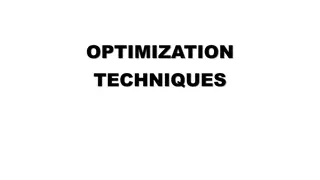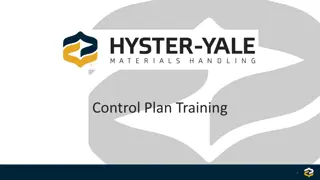Innovative Solutions for Process Control Optimization in Industrial Operations
This project focuses on developing robust and cost-effective process control technologies to enhance standards and efficiency in industrial operations. It aims to address challenges such as high costs of analyzers and data management in Process Analytical Technology (PAT) adoption. The proposed solution, ProPAT, offers an integrated platform for real-time monitoring, quality control, and efficiency improvements through advanced sensors and data analysis methods.
Download Presentation

Please find below an Image/Link to download the presentation.
The content on the website is provided AS IS for your information and personal use only. It may not be sold, licensed, or shared on other websites without obtaining consent from the author.If you encounter any issues during the download, it is possible that the publisher has removed the file from their server.
You are allowed to download the files provided on this website for personal or commercial use, subject to the condition that they are used lawfully. All files are the property of their respective owners.
The content on the website is provided AS IS for your information and personal use only. It may not be sold, licensed, or shared on other websites without obtaining consent from the author.
E N D
Presentation Transcript
Robust and affordable process control technologies for improving standards and optimising industrial operations Pau Puigdollers Project Coordinator
Quick overview Topic: SPIRE 1 Integrated Process Control Grant Agreement no. 637232 Start date: 1stJanuary 2015 End date: 31stDecember 2018 Participants: 16 partners, 8 EU countries SME led project that also includes a technology start up, process industries, academia and institutes.
PROPAT: Making the process analytical technology (PAT) initiative a reality for the European process industries through integrated process control. PAT enables: a process to be monitored for real time release of the process, cutting down on the amount of testing downstream and optimising quality in real-time. quality cost reduction by moving quality control closer to the production line (in-line, on-line, at-line) and away from the post- manufacturing quality labs. Quality by Design- allowing a process to be optimised to obtain greater efficiencies and higher end quality through knowledge of the fundamental scientific principles behind a process and continuous control of a process.
What are the challenges of PAT adoption in the industry? High costs of analysers Lack of a flexible platform for the integration of different analysers into existing plants PAT generates large volumes of data that need to be managed ProPAT s flexible PAT integration and data management platform will remove the barriers to practical PAT adoption in the industry.
What is ProPAT? An affordable platform to facilitate Process Analytical Technology implementation for achieving more efficient and sustainable production processes. Key objectives To develop an INTEGRATED PROCESS CONTROL PLATFORM based on novel low cost real time on-line sensors and a versatile Global Control System Platform that acquires and processes the data To perform PAT and QbD implementation case studies in order to evaluate their impacts and demonstrate their advantages. To develop models for individual sensors and methods for analysing multisensory inputs
Specific outputs Expected outcomes: Novel MEMS-based SWIR compact spectrometer Novel lens-free microscope particle size analyzer Latest smart sensors Latest chemometric tools Global control platform Installed and validated in real production facilities
A more efficient process results in: Greater production capacity Easier and more predictable processing Less waste generated Cost savings Integrated process control is fundamental for a sustainable and efficient European process industry
Expected impacts Implementation of PAT in the European process industry To ensure a more efficient control of processes through on- line measurement and modelling critical quality attributes Increased resource and energy efficiency in plant operations in the short to medium term ProPAT will contribute to the creation of a CEN Workshop Agreement as a best practice document. Cross-sectorial technology transfer: Demonstration activities across 4 different process industries will ensure the cross sectorial technology transfer.
Beyond ProPAT boundaries The planned dissemination and exploitation activities will also ensure the technology developments reach other potentially interested sectors ProPAT is open to collaboration with similar projects and platforms to ensure a larger impact of the project results. The creation of a PAT standardization platform will allow the results of ProPAT to be uptaken by industries around Europe and beyond.
www.pro-pat.eu Thank you!























